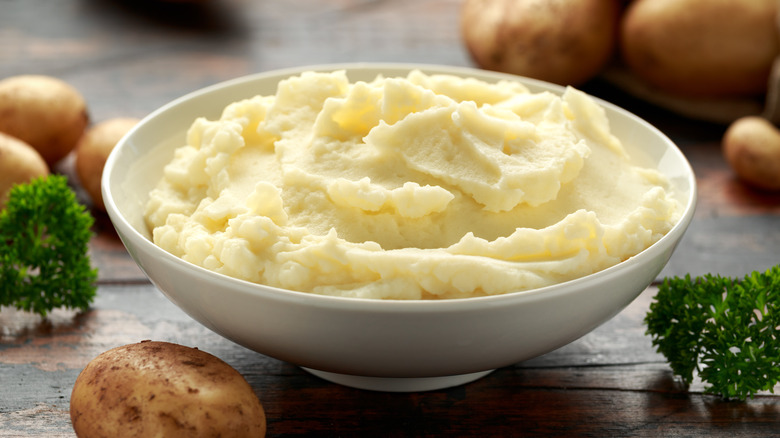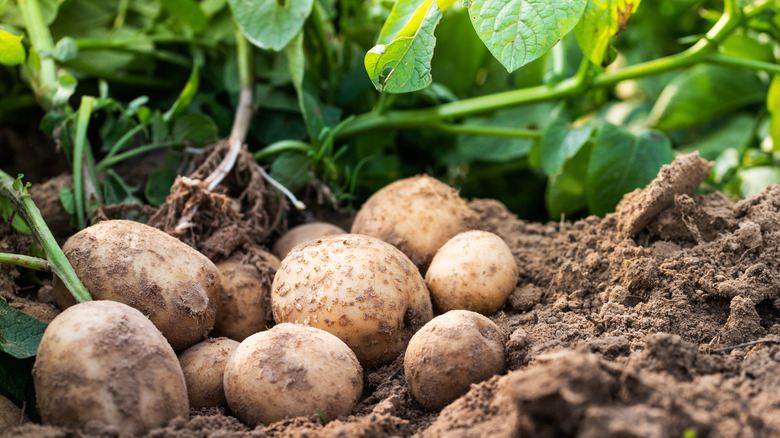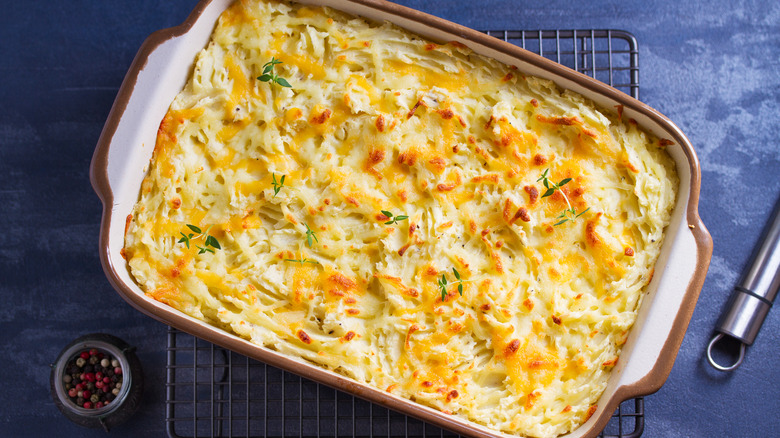Why Mashed Potatoes Were Once Considered An Aristocratic Dish
From the Irish mashed potato dish called colcannon to Iran's kuku sib zamini or potato patties, mashed potatoes are staples in many parts of the world. In Denmark, so much is the ardor for mashed potatoes that the dish brændende kærlighed's name translates to "burning love." Papa rellena, stuffed mashed potato balls, hail from the potato's homeland, Peru (via Taste Atlas). However, in Europe, the potato has a fraught history, fueled by the aristocracy's desire to preserve their wealth and exclusive customs.
Europeans first encountered potatoes in the 16th-century as they colonized the Americas, says Irish Central. According to Mental Floss, most likely, potatoes date back to 8000 BCE. Originally, potatoes were poisonous, but through millennia of cultivation, the indigenous people of Peru and Bolivia created a safe-to-eat potato. There, potatoes served as a staple for nutrients, one of the only plants that could grow at such high altitudes, says the Economic Times.
As a result of colonization, the potato journeyed to Europe. Upon arrival, Europeans met the potato with ambivalence, even hostility. The fact that potatoes could feed the poor cheaply and effectively threatened the land-owning aristocracy who sold crops to the government, which profited off crop taxes. An easy to grow and somewhat invisible food source like the potato would put the income of the aristocracy and government alike at risk (per Economic Times).
The one-person campaign to save the potato
European aristocrats launched a full-on smear campaign to ensure that no farmers would cultivate the potato. Rumors spread that potatoes caused leprosy. Others equated potatoes with poverty and laziness explains Economic Times. These falsehoods about potatoes prevented many poor and working-class Europeans from growing the simple, nutrient-rich crop. The French elite's potato panic was so extreme that in 1748 potatoes were outlawed, except for feeding them to animals, writes Irish Central.
This prejudice changed when a French man rediscovered the joy of eating potatoes. During the Seven Years' war, the aristocrat and pharmacist Antoine-Augustin Parmentier lived off potatoes in a Prussian prison camp. Parmentier delighted in his new starchy diet rather than dying of leprosy or suffering the debasement of eating "animal food" as superstitions suggested. He returned to France inspired to spread the good word about his new favorite food, explains Irish Central.
Parmentier set out on an 18th-century version of a rebranding campaign to challenge France's potato ban. He held dinner parties to show off the non-threatening and tasty food. He even performed potato mashing demonstrations. In 1772, thanks to Parmentier's potato advocacy, the French Government re-legalized potato consumption. No longer were potatoes relegated to animal feed (per Irish Central).
The new posh potato
However, with the potato's newfound status as edible, even delicious, the European aristocracy made their potato recipes fussy and complicated. Complex steps like mashing ensured that the working classes — without the time or resources — couldn't replicate upper-class potato recipes in their homes, explains the Economic Times. The late and Michelin-starred French chef Joel Robuchon's recipe for mashed potatoes mimics these ultra-complex and time-consuming recipes. His signature mashed potatoes call for boiling, peeling, milling, hand mixing, sieving, and finally, more hand-mixing to achieve his starchy delicacy.
Eventually, mashed potatoes made their way onto the tables of the world's working classes as a quick-to-make main dish with protein and vegetables added in for additional nutrients. Such is the case with the Irish colcannon. Around the same time, recipes for mashed potatoes appeared in English and American cookbooks, writes Irish Central. Ireland, in particular, grew to rely on the potato as a staple food since the tuber flourished in the Irish climate. Tragically, in the mid-1800s, when blight befell the potato in Ireland — and the British Government did little to help — over one million people perished (per Mental Floss).
With the hearty main-dish mashed potato recipes and the popularity of instant mashed potatoes in the mid-20th-century, the mashed potato was squarely once again a food of the people. Today, the mashed potato rests comfortably in elite and popular dishes. Its versatile status mirrors the potato's complex history.


